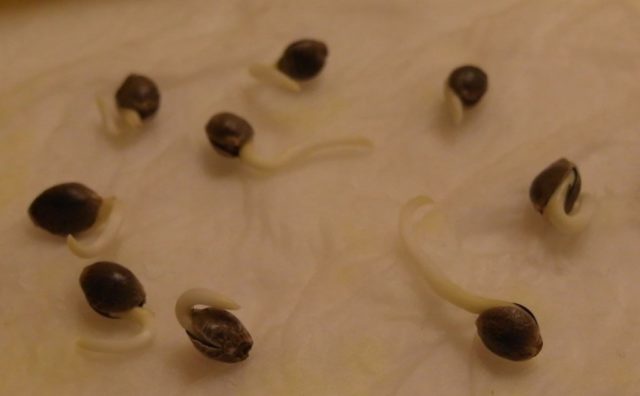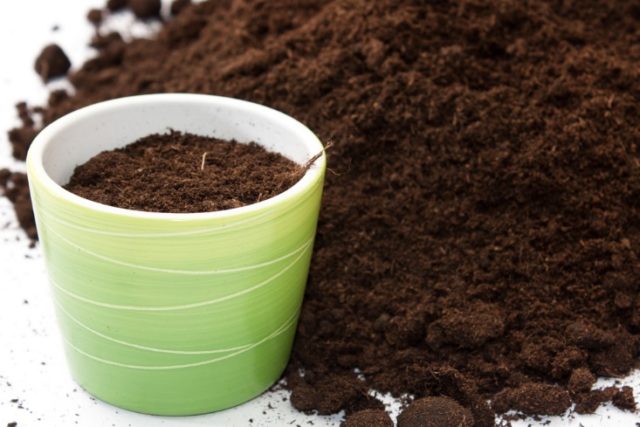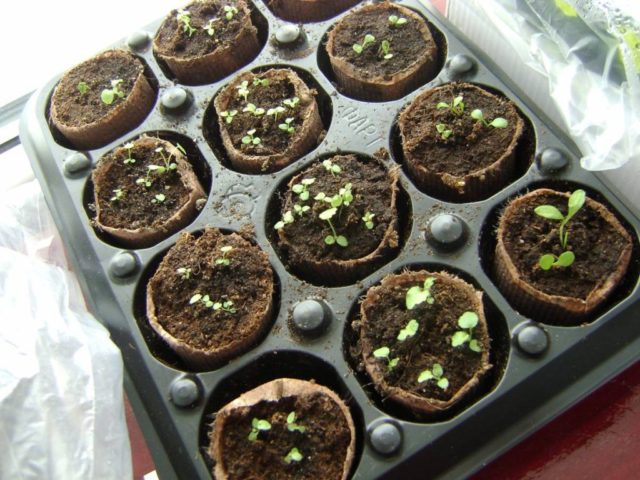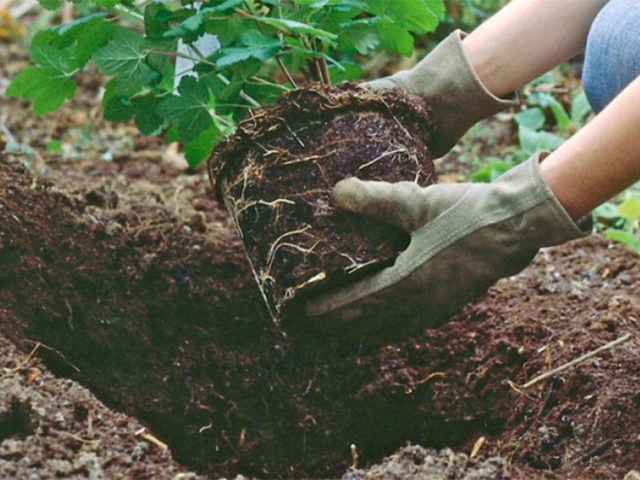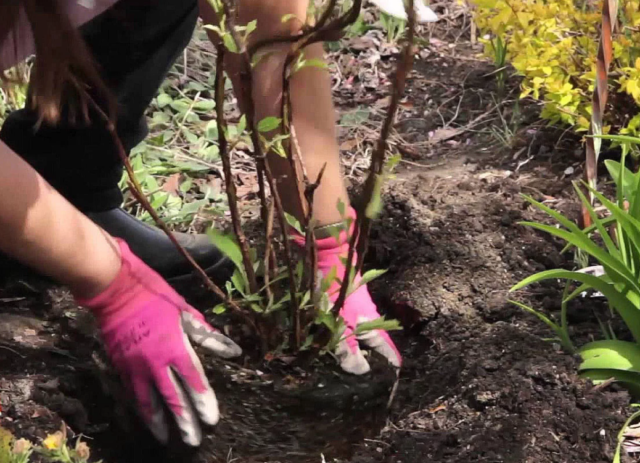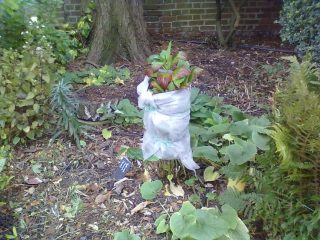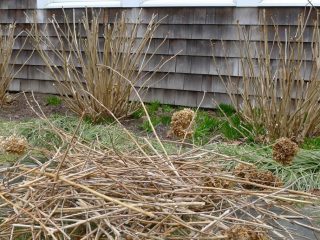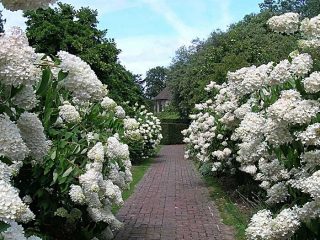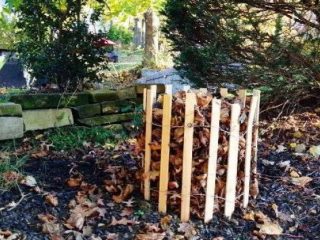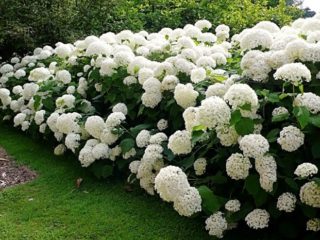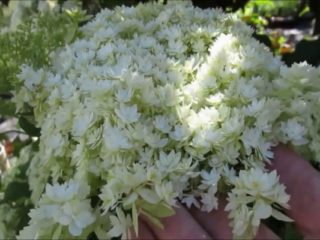Content
Hydrangea Magical Fire is actively used by landscape designers in various projects. To grow it yourself, you need to know how to properly care for the bushes.
Description of the variety of hydrangea paniculata Magical Fire
The name of this plant translated from English sounds like “Magic Flame”. The flower received this name due to the changing color of the petals during flowering. The flowers that appeared in the early period are pale pink. Then they turn bright red, turning into burgundy at the base of the inflorescence. At the end of flowering, the petals seem to burn out, and the shade changes again to pink, turning into purple.
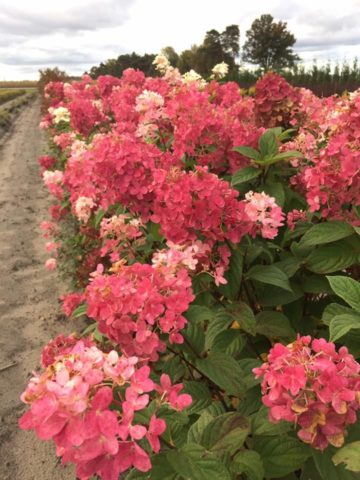
Adult “Magic Flame” has a bright red hue
Paniculate hydrangea is called because of the shape of the inflorescence. It is wide at the base and tapers towards the apex. The cone shape resembles a broom.Individual flowers are small, have 3-4 petals of a round, slightly elongated shape. The core of each of them does not exceed the size of a match head. It is colored yellow or orange. The cone-shaped brush in an adult plant can reach 20 cm in height and 10 cm in width. After flowering, the petals fall off and seeds ripen in their place. Their size is 5-6 mm and resembles apple seeds in appearance. The grains are dark brown or black.
Hydrangea Magical Fire has a strong trunk. Near the ground, it has 1 short thick stem, from which 8-15 branches grow, so the flower takes the form of a lush bush. The dimensions of a mature hydrangea are from 1.5 to 2 m in height, 1.8 m in width. The thickness of the branches is 1-2 cm, which allows you to hold heavy inflorescences and not sag under their weight. The root system of the flower is strong and branched. There are many thin processes that are important not to damage during transplantation.
The leaves of the flower are dense and smooth with clear veins. Their shape is lanceolate and their color is dark green. The leaves are distributed evenly across all branches. They grow in groups of 2, each directed in different directions. The gap between them on an adult plant is approximately 5 cm.
Hydrangea Magical Fire in landscape design
Hydrangea looks good together with other plants, and can also decorate the yard when planted alone. Designers recommend planting this flower in places where you need to hide a large gap between other bushes.
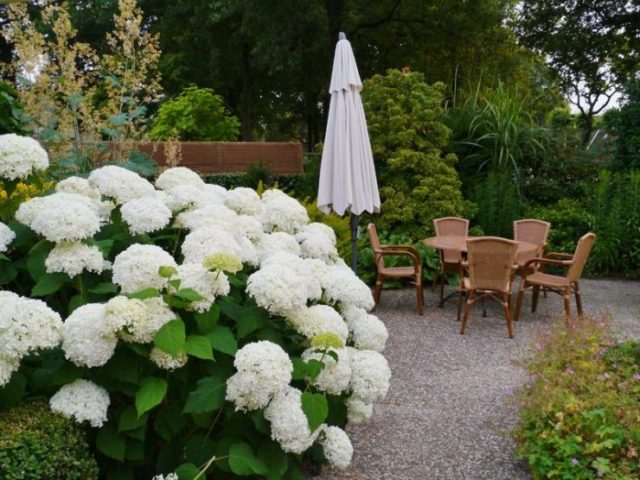
Magical Fire can act as a living fence, but only within a site, for example, separating a playground from a picnic area
Hydrangea is not suitable for the length of a fence separating a plot of land from a road or someone else's yard. Its crown is too soft and easy to get through.
The location of hydrangea on the site depends on the overall landscape design. In eastern styles, Magical Fire is usually planted near water (a pond or pool). In English gardens, hydrangea is placed in the center of large flower beds. In the country-style recreation area, Magical Fire is planted as a solid wall.
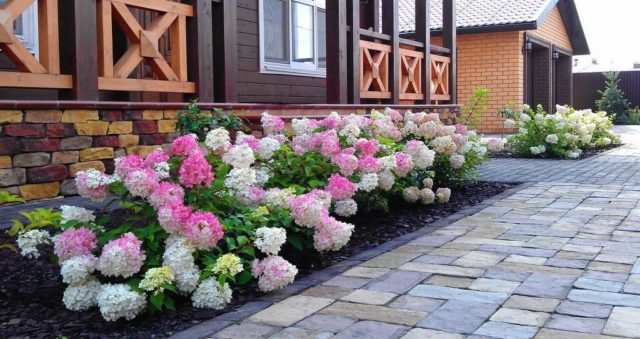
The plant looks good near the facade of the house, as well as near columns
Winter hardiness of hydrangea Magical Fire
This type of plant is frost-resistant. An adult hydrangea can survive frosts down to -35 °C without additional shelter, but in regions where winters are more severe, it will be required. In the first 2 years of life, Magical Fire must be carefully prepared for frost. After flowering ends, the base of the hydrangea bush is sprinkled with mulch. And with the onset of frosts from -10 °C it needs to be wrapped in a covering cloth.
Planting and caring for hydrangea Magical Fire
You can grow hydrangea at home from seed material in February. The seeds must be removed from the package and carefully inspected. They should not have white spots. The surface of high-quality grains is strong, without cracks or chips.
Procedure:
- The seeds must germinate before planting in the ground. To do this you will need cotton wool and boiled water at room temperature. A cotton roll is rolled out and the seeds are placed. They need to be covered on top with a second layer of cotton wool, slightly thinner than the bottom one. Then the surface is generously moistened with water using a spray bottle. After 2-3 days, the grains will swell and produce a white sprout.
Germinated seeds ready for planting have a sprouted white sprout
- It is best to grow seedlings in wooden boxes. The soil must be fertilized. Experienced flower growers advise digging up forest soil in the fall. This soil contains leaves, moss and pine needles, which forms good humus.
Forest soil is the best option for a pot of future hydrangea
- The grains are planted at a distance of 7-10 cm from each other. You need to make a small depression with your finger (3-5 mm), immerse the seed and sprinkle with soil. The surface of the soil is moistened with water from a spray bottle and covered with a transparent plastic bag or plastic plate. The optimal temperature for the early emergence of seedlings is + 18-21 ° C.
When green sprouts appear above the ground, the bag or lid can be removed
- Hydrangea Magic Fire needs to be replanted 2 times as it grows. After the first three leaves appear and in May, when the weather outside becomes warm. Two weeks before planting in the ground, seedlings need to be accustomed to outdoor conditions. They are taken out onto the balcony, first for a few hours, and later for the whole day.
Selection and preparation of a landing site
The Magical Fire variety prefers sunny or semi-shaded areas. In regions where the summer is hot, it is better to choose a semi-shaded area, and in the northern regions, on the contrary, it is recommended to root hydrangea bushes in sunny places.
The soil at the planting site should be rich in peat and have average moisture. In dry soil, the Magical Fire hydrangea develops slowly, and in too wet soil its roots rot.
The area needs to be cleared of weeds and a hole 30-40 cm deep must be dug. The width of the hole should be 2 times larger than the ball of plant roots. If you plan to plant several Magical Fire hydrangea bushes, then the distance between the holes should be at least 1.5 m. In each hole you need to lay out a layer of fertilizer: a mixture of peat and humus. You can crumble chalk along the edges.
Rules for planting hydrangea Magic Fire
To successfully transplant paniculate hydrangea, you need to follow the following procedure:
- Before you drag the flower out of the pot, you need to water it generously. When the soil softens, carefully turn the container over into the canopy, holding the seedling at the roots with your hand.
If the soil with roots comes out tightly, you need to shake the pot slightly
- When the roots are completely removed, they are lowered into the prepared hole and covered with earth. Then you need to lightly compact the soil under the base of the hydrangea bush.
It is important that the roots do not remain above the soil surface
- The seedling is watered and the soil is loosened.
Watering and fertilizing
Hydrangea Magic Fire accepts fertilizing well, and with timely fertilization, the plant blooms more abundantly and luxuriantly. After planting at the end of May, the bushes can be fertilized by watering them with slurry and water in a ratio of 1:10, as well as with minerals, which should be purchased in the store. The powder is dissolved in water, corresponding to the dosage indicated on the package, and the flower is watered.
Feeding is repeated after 2 weeks. When the first buds appear on the branches, you need to use fertilizers containing phosphorus and potassium. This feeding is repeated 2 times, during periods of changing leaf color.
Magical Fire loves damp soil, so watering is required once a week, provided there is no rain. One bush requires 15 liters of water. If the climate is normal and rainfall occurs every week, then it is enough to check the soil moisture and water only once a month.
Pruning Hydrangea paniculata Magik Fire
Pruning allows Magic Fire hydrangea bushes to grow fuller and more beautiful.In the spring, it is necessary to remove all dead branches using pruning shears, and shorten healthy shoots to 2-4 buds.
When the hydrangea begins to gain color, you need to cut off the weakest inflorescences. This will help direct all vital forces to the development of healthy flowers. If pruning is not done in time, the buds will develop slowly, as the hydrangea will begin to feed the damaged flowers, and the nutrition of healthy clusters will be reduced.
Preparing for winter
Before the first frost, Magical Fire needs to be earthed up by burying the stem to 20-30 cm. This will help prevent freezing of the upper part of the roots. It is advisable to cover the root zone with a thick layer of mulch. It is best to wrap young seedlings with a special covering material before the first snow.
Adult Magical Fire hydrangea bushes require such protection only at temperatures below - 35 ° C. It is not recommended to water the flower 2 weeks before the expected date of frost. A layer of mulch retains all the necessary water, and excess moisture can cause frostbite to the roots.
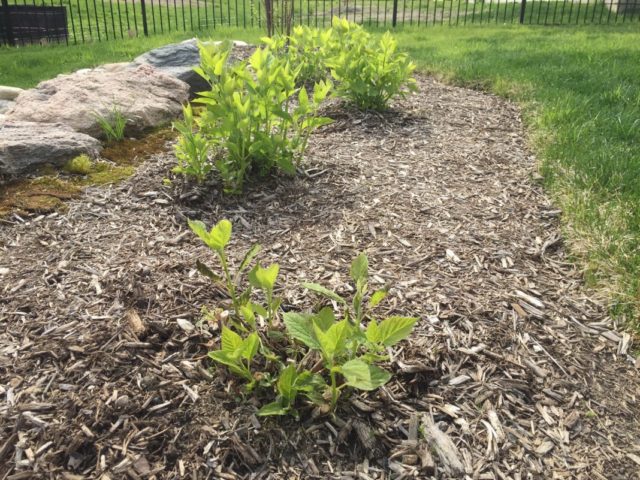
Mulching seedlings in the fall will allow hydrangeas to survive even a harsh winter.
Reproduction
Magical Fire hydrangea reproduces in the same way as other species from this plant family. The table below describes the propagation methods in more detail:
Cuttings | From an adult plant, the green part of the branch, which has 4-8 leaves, is cut off at an angle of 45°; the top is left flat, without tilting the cut. Germination is carried out in home pots filled with a mixture of peat, sand and distillation. |
Dividing the bush | Large bushes of Magical Fire hydrangea can be carefully divided. To do this, find a place where there is a second thick leg. Lightly dig up the soil at the roots, after watering it abundantly.The separated part is pulled out and transplanted to another place. |
Offspring | A young shoot is found at the roots and carefully separated from the adult plant, being careful not to damage the roots. The offspring can be transplanted directly into open ground. |
Layerings | In the spring, before the buds appear, grooves are dug near an adult hydrangea, where the outermost, young branches are placed. They are covered with earth and secured with spears. By autumn, the branches will take root and new shoots will begin to sprout. |
Diseases and pests
Paniculata hydrangea is susceptible to two types of diseases: powdery mildew and aphids. In the first case, the leaves become covered with yellow spots and the flowers fade. To help an infected plant, it needs to be sprayed with Bordeaux mixture or foundationazole.
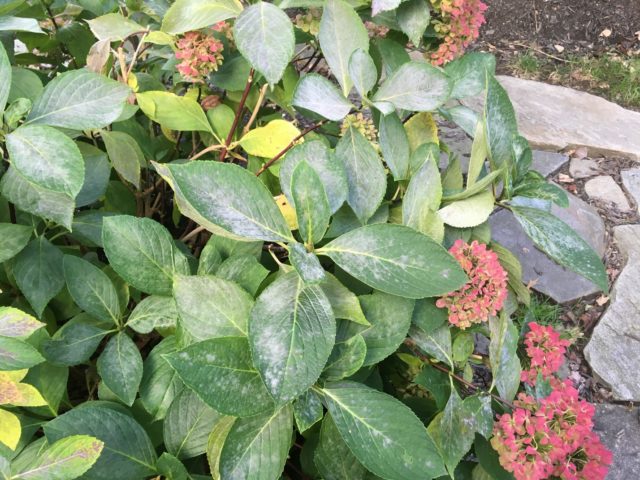
Powdery mildew affects hydrangea leaves, covering them with a white coating
When aphids settle on Magic Fire bushes, they spin sticky webs, chew leaves and flowers, and twist them. To get rid of pests, you will need garlic tincture. It needs to be sprayed on the hydrangea until the aphids are completely gone.
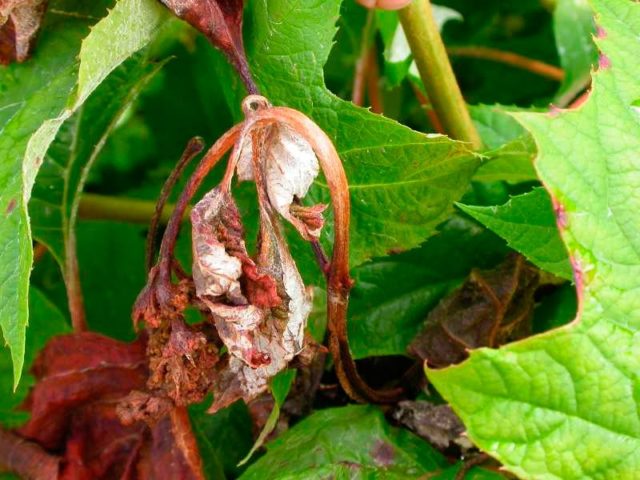
Flowers affected by aphids quickly wither and dry out
You can learn more about hydrangea diseases from the video:
Conclusion
Hydrangea Magical Fire is an unusual variety of flowering bushes that is suitable for decorating any area. The main thing is to plant correctly and follow the care recommendations.
